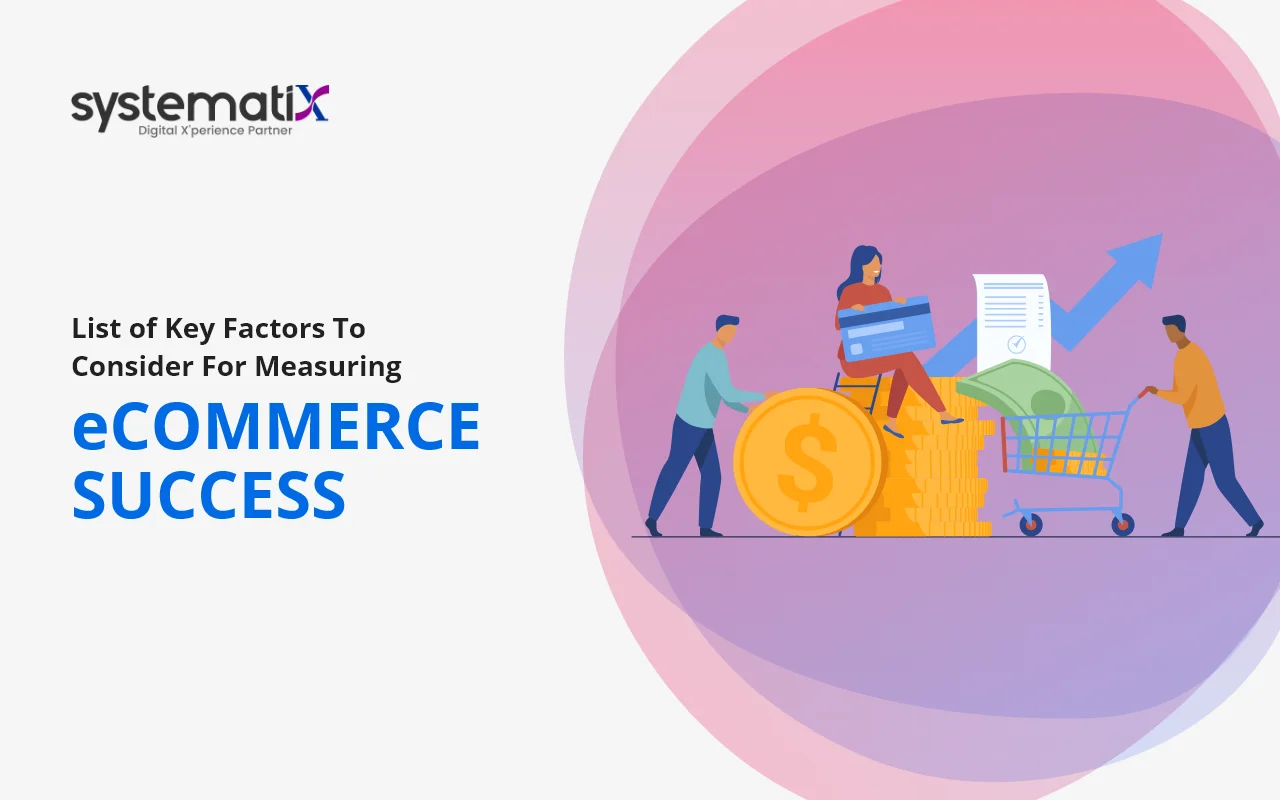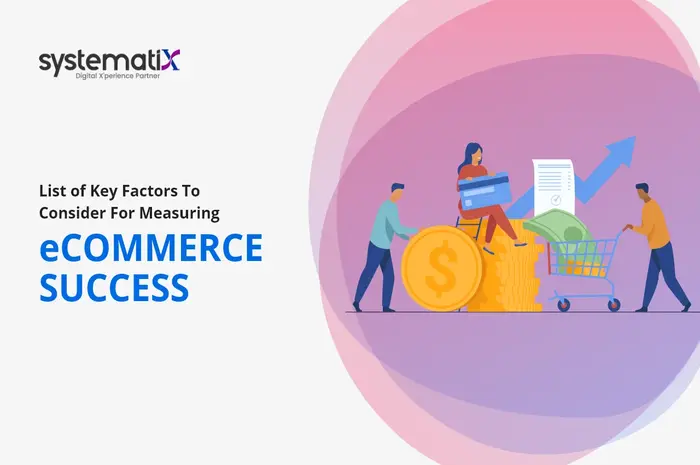
Today, there are a rising number of e-commerce enterprises offering a diverse variety of products and services. With more numbers comes increased competitiveness. Data is critical for staying ahead of your competition in the market. To get started, you’ll focus on e-commerce website development to establish your firm. Following the launch, you should begin analyzing your E-commerce KPIs.
Keeping track of these critical data will aid in the growth of your organization. These indicators can be used to analyze your business’s performance. Measuring the appropriate E-commerce metrics can assist you in making sound business judgments. It can assist you in determining which areas require attention and optimization.
Why Should You Track Your Online Success?
The bottom line is that success is meaningless without quantifiable results. Monitoring your E-commerce and business applications may reveal a lot about how your business in the long run – and help you discover opportunities for improvement. The following are a few advantages of developing an analytics strategy to measure your E-commerce success:
Strengthen your pitch to investors – Consider pitching your brand on Shark Tank with no figures or facts to support your success. Does it not appear to be kind of fictional to them? Having good outcomes to back up your business is a critical predictor of future success. Furthermore, the more precise your statistics, the more information you’ll get regarding how and where investors might assist you in growing, such as by diversifying your marketing channels or capitalizing on opportunities to increase your ROI.
Real-time monitoring of outcomes – A glance at an analytics console can inform online marketing specialists when a landing page is unavailable or when a surge of new visitors arrives on your website.
Google Analytics, for example, provides a real-time overview and customizable choices for creating a daily dashboard. It is also a service that certain e-commerce website development companies, such as BigCommerce, provide.
By gathering data and monitoring outcomes in real-time, you may instantly modify or alter your website’s or business strategy in response to observed activity. This enables you to identify issues before they get too complex, allowing you to optimize the customer experience sooner and thereby keep your customers satisfied.
A comprehensive perspective – When you examine critical indicators for your E-commerce business — either they pertain to an advertising campaign or general performance — you’ll notice that they frequently tell a tale. Perhaps you discover that your firm receives a lot of organic search traffic. This might be a sign that you should maintain a strong search engine optimization (SEO) approach.
Or maybe you’re experiencing an exponential increase in new consumers. This may be a sign that your internal marketing techniques – maybe social media – are doing well. Or — now you’re generating a high volume of visits from non-converting customers. This might indicate that you need to rethink your E-commerce site’s marketing strategy or your traditional marketing techniques for which you can hire e-commerce experts.
Key Factors and Metrics to Consider For Measuring E-Commerce Success
#1 A Customized Purchasing Experience
Personalization technologies enable companies with a high rate of success in E-commerce to be customer-centric and create a personalized experience for each consumer. To be a customer-friendly business, you must showcase your information and sales pitch appropriately via Custom web development. You must accurately incorporate product recommendations and specialized suggestions based on users’ behavior, previous actions, online history, demographic data, and other rich personal data.
When compared to traditional shopping, you’ll note that shops also propose and explain their items based on the buyer’s needs and preferences. The human component contributes to competitive advantage. That is the purpose of customization — to replicate the experience a customer has at a store online through a tailored purchasing route.
Personalization of offers is accomplished through channels like social media and monitoring technologies for search engines. They enable the extraction of a plethora of personal information about clients. This information includes search results, page views, and purchase history, among other things. “Personalization is a crucial step for a profitable business and is critical for increased purchasing and the sustainability of e-commerce,” asserts Juha Valvanne, CEO of Nosto, a technological platform that enables personalized e-commerce.
Customers will purchase nearly half as many things if they get what they desire. They may be unaware that they are fascinated by the goods, but based on their online activities; you may infer that they will require it. The majority of internet customers are willing to answer any of the questions with a business if it helps them make a purchase.
If you utilize the appropriate strategies to customize items for your consumers, they will feel as if you are familiar with them, as if you were a friend or family. This emotional appeal instills loyalty in the recipient. You may hire e-commerce developers for implementing faster personalization.
#2 Maintain A Close Watch On Social Media Trends
Social media contributes to a business’s online presence. It is also critical to the success of E-commerce. According to the report, over 3 million people would be utilizing one or more social media platforms for e-commerce success in 2021. The reason for this is because businesses nowadays understand how critical social media platforms are to their E-commerce growth. The popularity of social media platforms continues to grow daily. Around 80% of internet campaigns are already active.
Customers’ attention spans are decreasing, and e-commerce businesses must ensure they attract users’ interest immediately. As an E-commerce business owner, you should hire the Best web development company that assists you in making an attractive E-commerce website for you. There is indeed a lot to look forward to in the terms of E-commerce success, from chatbot to artificial intelligence.
Social commerce is also an unavoidable trend. In contrast to social media marketing, social commerce does not include redirecting consumers to your online store. Buyers can purchase goods using the web browser they are currently using. Social commerce, when paired with celebrity endorsements, has the potential to significantly enhance sales. Numerous businesses use celebrities to promote a certain brand and attract clients.
Experts expect that this trend or pattern will continue to rise since 65 percent of major corporations’ marketing expenses grew in 2020 alone. Over 5% of brands want to invest more than a thousand dollars each year in this approach. Celebrity endorsements have existed since the birth of social media. The objective is to get celebrities and individuals with sizable followings to endorse the items.
To stay ahead of the competition, you’ll need to work with well-known individuals for paid social media postings. We anticipate that this trend will continue and develop.
#3 Multiple Payment Options
As of a few years ago, the vast majority of e-commerce firms were confined to accepting payment via Credit Cards and Debit Cards. However, things have altered significantly with the emergence of digital wallets. PayPal is a popular e-wallet that brands have adopted, and Google Pay is now getting on board. Now, firms are attempting to incorporate as many major payment methods as possible onto their website to avoid situations when online buyers feel they have no choice but to leave the transaction until the last minute.
Today, if you do not offer numerous payment choices to your clients, you risk losing significant conversions, and you certainly do not want people to quit at the final stage of their checkout. By offering different payment channels, you permit clients to trust you. The more purchasing choices you provide, the more competence and credibility you demonstrate to clients. You can integrate multiple payment options through custom web development or by hiring an e-commerce development company. Let us see in more detail how having multiple payment options contribute to the success of your E-commerce business.
Backup In Case One Payment Option Fails – If you only offer one method of payment to your consumers, what happens if that method fails? Do you even have a strategy in place for that? Multiple payment gateways give an alternate payment method if one payment method has difficulties. In the occurrence of sales overflows and surges, a different payment system can handle sales.
Customers Appreciate Having Several Payment Options – Buyers like the variety of payment methods available. Your key target buyers may opt to use PayPal rather than enter their credit card information. When you accept PayPal as a payment method, you enhance your sales.
Get More Analytical Data – Utilizing various payment channels enables you to capture extra customer data. Each payment gateway is unique in its functionality and provides a wealth of analytical data. For example, one payment method may enable you to collect information about your customers based on their currencies, state, or nation. Collecting this additional data can help you make more educated business decisions and provide insight into how to enhance payment processing.
Expand Sales Internationally – One advantage of an online store is that it enables you to sell to everyone in the globe, something that is not possible in a brick-and-mortar store. However, selling overseas may necessitate the installation of additional gateways. Once your firm expands globally, you will need to process payment in the countries where your target audience lives. Allowing overseas clients to purchase sets the standard for your business.
#4 Effective Content Marketing Strategy
Content marketing is a critical component to consider when determining your e-commerce performance. This way, you can engage and maintain your e-commerce store’s consumers. It has been shown that great marketing trends demand high-quality content to attract the greatest number of people. From videos to advertisements to broadcasts, content is what can propel your firm to new heights of e-commerce success. You can consider the following steps for developing an e-commerce content strategy:
Step 1: Become acquainted with your customers’ purchasing cycles
Before you can grow (or initiate) a content strategy, you must first understand your users’ search behavior and how it connects to your website. “Buying cycles” might assist you in narrowing your focus. Every competent marketer understands that the sales/purchasing cycle is multi-staged. We’ve streamlined them slightly for your convenience.
- Uninformed Shoppers Seeking Alternatives – These customers are in the early potential stage of the purchasing process. They’re looking for solutions inside a specified category, such as “boots” (which is the most generic) or “men’s boots”. They are prepared to be informed about their different possibilities.
- Convincing Educated Shoppers – Conversion rates on early visits from uninformed customers are often lower than those on subsequent visits from intelligent customers. However, somewhat informed customers may be more willing to “convince themselves” to make a purchase – and hence have a greater conversion rate.
- Shoppers Who Are Aware of Their Needs – At this stage of the purchasing cycle, shoppers generally know whatever they want — and they’re looking for it explicitly via product names. While these customers are not yet ready to purchase, they have identified something they desire.
- Shoppers Who Are Prepared to Purchase – These customers have already made up their minds and are prepared to purchase. They are most likely looking for information about your brand, your store’s hours, address, and so on. Ascertain that all of this information is easily accessible and also that your conversion web pages are optimized for their consumption.
Step 2: Determine the Content Types to Utilize
E-commerce content marketing strategy involves more than just improving products and other web pages. The most successful Top ecommerce companies in USA take full advantage of their blogs, social media platforms, pictures, and video streams to enhance visibility for their items and conversions.
Step 3: Develop a Distribution Strategy
It’s pointless to produce content for your e-commerce website if you can’t adequately advertise it. Pages optimized for certain keywords may eventually receive organic traffic, but in the meanwhile, you must distribute your material via more immediate outlets.
Distribution is a critical component in developing an effective content marketing plan. Likewise, do not leave it till the end. Consider the distribution of your material across platforms as you design a plan, and you’ll save yourself time and work afterward. You can hire e-commerce experts who can make this process easier for you.
#5 Design of the store
Apart from the numerous distinctive features, the only thing that attracts and retains a client’s attention is undoubtedly the user interface and appearance of your e-commerce store or website. Make sure you approach the best web development company to get your store designed as it serves the most crucial part in sales.
However, please note that not everyone makes purchases using the same sort of gadget. With an increasing number of people utilizing mobile devices, a website must adapt appropriately to the screen resolution and size of the screen being used. As a result, hire e-commerce developers who can make your E-commerce store compatible with various devices.
Utilizing minor animations, the appropriate colors, graphics, and unique scroll functionalities may have a significant impact on your e-commerce business. Furthermore, there are several templates available that provide a range of themes for customizing your e-commerce site.
#6 Customer Lifetime Value (CLTV)
Customer Lifetime Value (CLV) measures a customer’s entire value to a firm over the length of their interaction. It compares the revenue value of a client to the company’s expected client longevity. This statistic is used by businesses to assess which consumers are by far the most profitable to them.
Furthermore, it indicates how much money you must spend on a certain consumer to keep them. Therefore, it serves as one of the key factors in determining your E-commerce success.
#7 Cost of Customer Acquisition (CAC)
CAC is a term that refers to a company’s overall sales and marketing costs associated with acquiring a new client over a specified period. It is synonymous with the CLTV metric. Oftentimes, acquiring new clients is more expensive than maintaining existing ones. To attract new clients, you may need to invest more money in different marketing and advertising activities.
Both Customer Lifetime Value (CLTV) and Cost of Customer Acquisition (CAC) must be compared to one another. If the cost of client acquisition exceeds the client lifetime value, your E-commerce business may be losing money. Reduced CAC indicates that the firm is operating more effectively and should anticipate more earnings.
There are several methods for reducing CAC. For instance, if you get organic prospects through blog material, you won’t need to invest much in advertising. If your sales force is consistently nurturing potential prospects, you do not need to employ more representatives. If your present clients are satisfied, you can gain new consumers based on their positive ratings. It’s all about maximizing your resource use. The CAC is computed by dividing the cost of marketing and sales by the amount of newly gained clients.
Conclusion
So far anyway, we’ve discussed the numerous criteria which must be considered when evaluating an e-commerce business’s performance. That’s because the e-commerce business is at an all-time high right now. To compete effectively against the fierce competition, you must launch your e-commerce firm in a scalable and lucrative manner. As a result, you’ll need the variables outlined above to evaluate your e-commerce performance.







